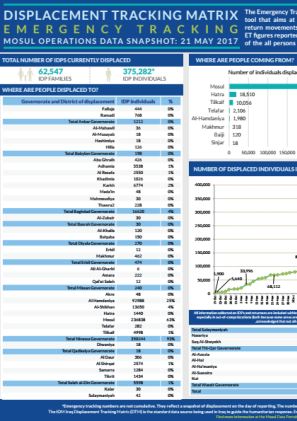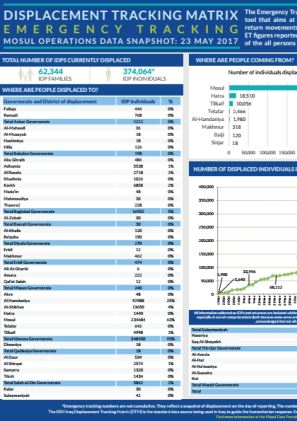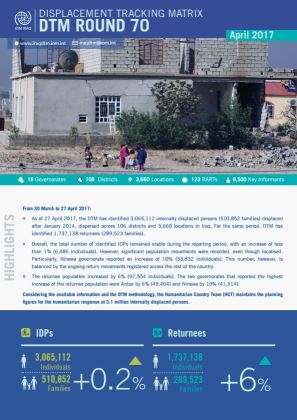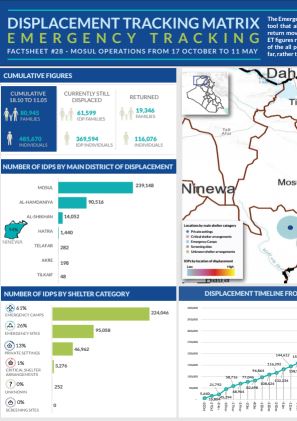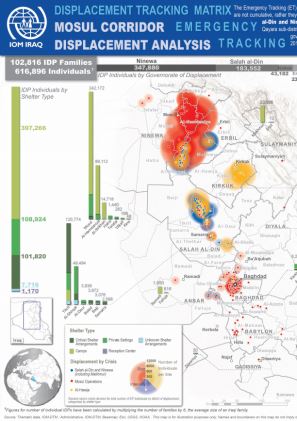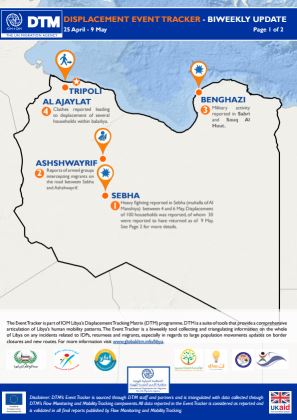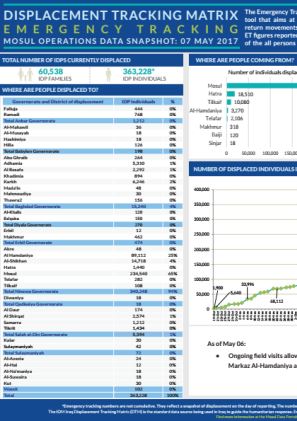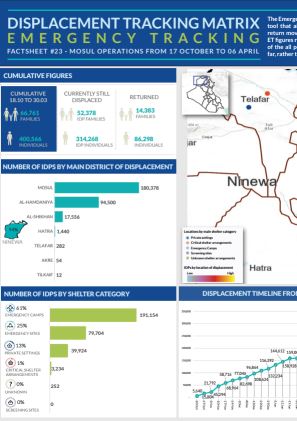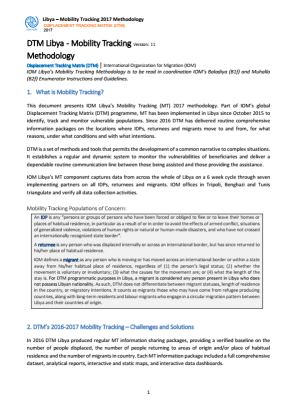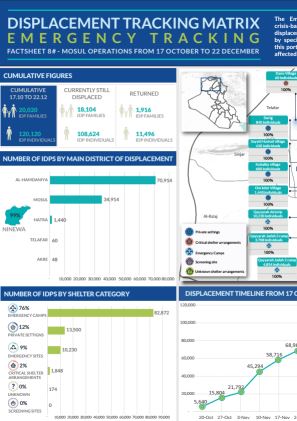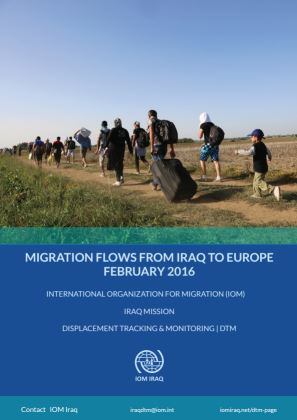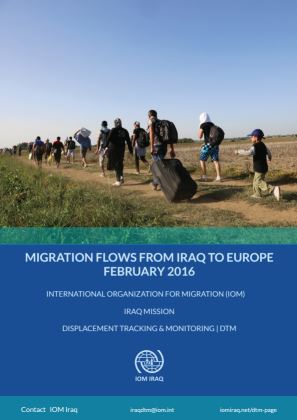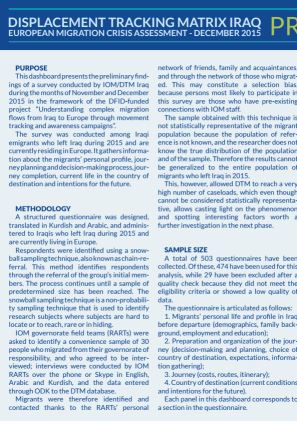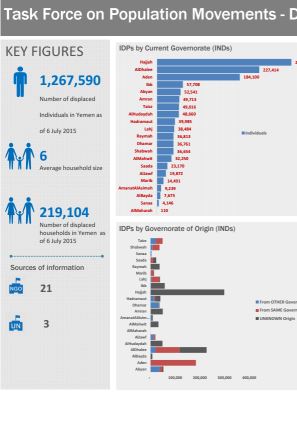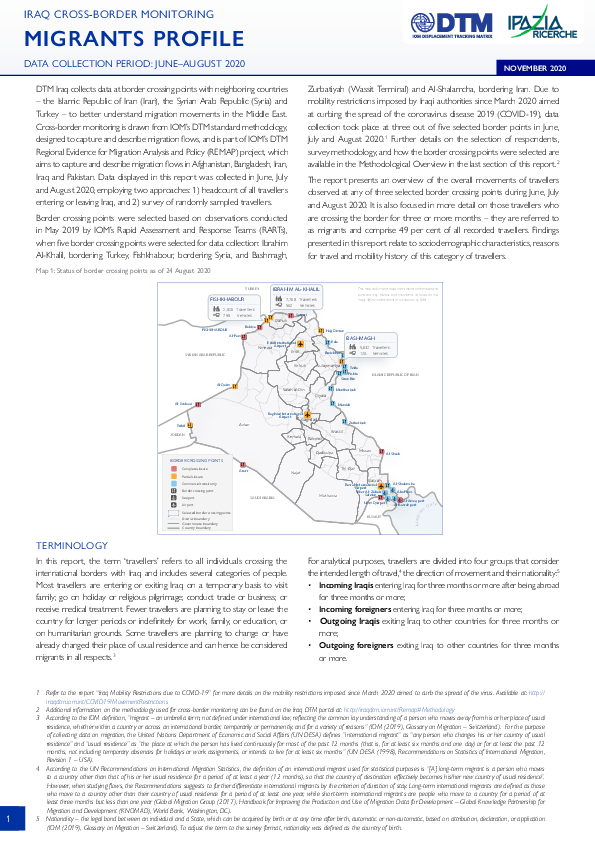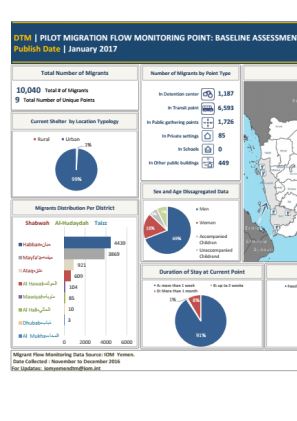-
Countries
-
Data and Analysis
-
Special Focus
-
Crisis Responses
Middle East and North Africa
DTM Middle East and North Africa
DTM Operations in the region
- Active DTM operation
- Past DTM operation
Para obtener resultados de búsqueda más avanzados, vaya a la Página de búsqueda avanzada de informes
Iraq — Emergency Tracking Factsheet 30 (25 May 2017)
DTM identified 62,901 IDP families (377,406 individuals) and 20,644 returnee families (123,864 individuals) in and around Mosul. 59% of displaced people are living in emergency camps and 24% are living in emergency sites.
Iraq — Emergency Tracking Mosul Operations Data Snapshot (21 May 2017)
The total number of identified IDP families displaced as of 21 May was 62,547 (an estimated 375,282 individuals). Most people (342,174 individuals) are coming from Mosul and are living in camps or emergency sites (318,396 IDPs).
Iraq — Emergency Tracking Mosul Operations Data Snapshot (23 May 2017)
DTM identified 62,344 families (374,064 individuals) who are currently displaced. Most of the identified IDPs originated from Mosul district (340,596 individuals). Ninewa governorate hosts the highest number of IDPs (348,450 individuals).
Iraq — Displacement Report 70 (April 2017)
As of 27 April 2017, DTM has identified 3,065,112 internally displaced persons (510,852 families) displaced after January 2014, dispersed across 106 districts and 3,660 locations in Iraq. For the same period, DTM has identified 1,737,138 returnees (289,523 families).
May 11 2017
Iraq — Displacement Report 70 (April 2017)
Iraq — Emergency Tracking Factsheet 28 (11 May 2017)
DTM identified 61,599 families (369,594 individuals) currently still displaced in the Mosul area. 19,346 returnee families (116,076 individuals) were also identified. Mosul is the main district of displacement with 239,148 IDPs identified there.
Iraq — Emergency Tracking Mosul Corridor Displacement Analysis (8 May 2017)
As of 8 May 2017 DTM has identified 102,816 displaced families. The majority (over 50%) of displaced persons were residing in camps, followed by private settings.
Libya — Displacement Event Tracking Report (25 April — 9 May 2017)
Displacement events were recorded in Tripoli, Al Ajaylat, Benghazi, Ashshwayrif and Sebha.
Iraq — Emergency Tracking Mosul Operations Data Snapshot (7 May 2017)
DTM identified 60,538 IDP families comprised of approximately 363,228 individuals. Mosul was the most commonly cited district of origin (328,806 individuals) followed by Hatra (18,510).
Libya — Maritime Incidents Update (31 March – 9 April 2017)
During the reporting period 295 people were rescued and 1 body was retrieved. 3,977 individuals have been rescued thus far in 2017.
Iraq — Emergency Tracking Factsheet 23 (6 April 2017)
The cumulative total of IDPs recorded by DTM during this period was 400,566 individuals comprising 66,761 families. Of these, 314,268 individuals (comprising 52,378 families) are still displaced. 191,154 people are currently residing in emergency camps.
Libya — Maritime Incidents Update (16–30 March 2017)
During the reporting period 1,037 people were rescued and 23 bodies were retrieved. 3,682 individuals have been rescued thus far in 2017.
Maritime Incidents Libyan Coast Update (30 March 2017)
During this reporting period, 16–30 March, a total of 1,037 migrants were rescued off of the Libyan Coast (409 from Zuwara, 402 from Az-Zawiyah, and 223 from Tripoli) and 23 bodies were retrieved (14 from Az-Zawiyah, 5 from Zuwara, and 4 from Sabratha).
DTM Libya - Flow Monitoring Methodology
This document presents DTM Libya Flow Monitoring methodology, the Baseline Assessment V.11 forms with notes and guidelines, and IOM’s 5.1 DTM Flow Monitoring Survey form.
Jan 01 2017
DTM Libya - Flow Monitoring Methodology
DTM Libya - Mobility Tracking Methodology
This document presents DTM Libya Mobility Tracking methodology, IOM Libya’s Mobility Tracking Methodology is to be read in coordination IOM’s Baladiya (B1F) and Muhalla (B2F) Enumerator Instructions and Guidelines.
Jan 01 2017
DTM Libya - Mobility Tracking Methodology
Iraq — Emergency Tracking Factsheet 8 (22 December 2017)
The cumulative total of IDPs recorded by DTM during this period was 120,120 individuals comprising 20,020 families. Of these, 108,624 individuals (comprising 18,104 families) are still displaced. 82,872 people are currently residing in emergency camps (76% of the total).
Europe — Flow Monitoring Surveys in the Mediterranean and Beyond: Adult respondents (9 October 2015 — 11 July 2016)
Between 9 October 2015 and 11 July 2016 IOM field staff in Greece, the Former Yugoslav Republic of Macedonia, Croatia, Serbia, Slovenia, Hungary and Libya conducted interviews with 10,608 migrants and refugees.
Europe — Flow Monitoring Surveys in the Mediterranean and Beyond: Adolescent Youth (8 October 2015 — 30 June 2016)
This week’s report focuses on providing an analysis on adolescent youth between the ages of 15 and 18. The analysis includes a sample of 605 respondents interviewed during this period. Afghan, Syrian, Iraqis, Pakistanis and Moroccan youth comprise 96% of the respondents’ surveyed.
Europe — Flow Monitoring Surveys in the Mediterranean and Beyond (1 May — 13 June 2016)
This week’s report focuses on providing an analysis on Syrian, Afghan, Iraqi, Pakistani and North & West African nationals (sample of 854 respondents). The average respondent was 27 years old. Men comprised 85% of all individuals surveyed.
Iraq — Migration from Iraq to Europe (February 2016)
This report presents the findings of a survey conducted by IOM Iraq during the months of November and December 2015, in the framework of the DFID-funded project “Understanding complex migration flows from Iraq to Europe through movement tracking and awareness campaigns”.
Iraq — Migration from Iraq to Europe (February 2016)
This report presents the findings of a survey conducted by IOM Iraq during the months of November and December 2015, in the framework of the DFID-funded project “Understanding complex migration flows from Iraq to Europe through movement tracking and awareness campaigns”.
Iraq — Migration from Iraq to Europe (December 2015)
This dashboard presents the preliminary findings of a survey conducted by IOM/DTM Iraq during the months of November and December 2015 in the framework of the DFID-funded project “Understanding complex migration flows from Iraq to Europe through movement tracking and awareness campaigns”.
Yemen — TFPM Report Dashboard 3 (6 July 2015)
As of 6 July 2015 1,267,590 IDPs comprising 219,104 were identified in Yemen. These dashboards show the spread of these IDPs across 21 governorates and indicate the numbers of IDPs displaced within and outside their governorates of origin.
Iraq – Iraq Cross-border Monitoring Migrants Profile (June - August 2020)
DTM Iraq collects data at border crossing points with neighboring countries – the Islamic Republic of Iran (Iran), the Syrian Arab Republic (Syria) and Turkey – to better understand migration movements in the Middle East.
Yemen – Pilot Migration Flow Monitoring Point: Baseline Assessment (January 2017)
10,040 migrants were recorded across 9 flow monitoring points. 1,187 were recorded in detention centers, 6,593 at transit points, 1,726 at public gathering points, 85 in private settings and 449 in other public buildings.
Pagination
Para obtener resultados de búsqueda más avanzados, vaya a la Página de búsqueda avanzada de conjuntos de datos
Pagination
- First page
- Previous page
- …
- 31
- 32
- 33
- 34
- 35
- 36
- 37
- 38
- 39

